Waterfront Phoenix

Frank and Nancy Marchetti had only lived in their 1940s cottage for about one year before the fire.
“They said it was either the icemaker in the refrigerator or the dishwasher. It started in the kitchen and it just went up, quick,” Frank recalls. “There was no sheetrock in the house; all the walls and the ceiling were knotty pine. Everything was wood.”
Had the fire occurred before the first flame took off at 8:30 a.m., their teenage daughter would have still been home—in her bedroom just outside the kitchen—and Nancy would not have been at work yet.
“I was up at another property around the corner doing some chores. I heard all the sirens going off, and as the smoke started going up, I looked over and actually thought it was down at the marina,” Frank tells. “Then I started coming back and saw it was a lot closer—and then I turned down the street and said, ‘Oh God, it’s our house!’
During the chaos of fire trucks and flames, the family cat ran back inside the home, seeking what he thought was safety underneath the master bed. “There used to be a spiral staircase going down to the master bedroom. I went running in to grab the cat, and I’m looking up the spiral staircase—it looked like an inferno,” Frank describes. “The whole house was on fire. Just as I grabbed the cat, one of my neighbors grabbed my ankles. He pulled me out from under the bed and I pulled the cat up. He said, ‘Frank, it’s time leave, now.’ All of the animals got out and we were safe. We lost a lot of personal stuff, but you kind of learn that it’s all—as important as it is—it’s all just stuff.”

The front door, originating from the 1800s, was stripped by homeowner Frank Marchetti. Photo by Bethany Turner
Luckily, the Marchettis owned a home in Southport which was staged with furniture. That house became their refuge, and Farm Bureau Insurance offered a check for living expenses within hours of the fire. (By the way, the cat Frank saved is now 19.) “Between that and the town just coming out for a couple of Yankees, it was really, really something,” Frank says, taking a pause to collect himself. “I get choked up because the people in this town are so fabulous—people we didn’t even know. It was phenomenal.”
Frank and Nancy originate from Connecticut and had a 40-acre horse farm in Massachusetts; they moved to Southport with their daughter eight years ago. “We came down here on a five-day vacation. We’d never been to Southport; friends of ours had a place over on Rhett Street,” Frank, retired from General Dynamics, details. “On the third day, we bought a house and decided to move down here, and we never looked back.”
Much of the allure of Southport lies in its people, Frank notes. “New Englanders are tough to get to be friendly with. You could be in a town you moved into for 20 years, and you’re still a newbie,” he muses. “Typically old New England people. Down here, what they call Southern hospitality is so true. Not that there aren’t great people up north, but down here they’re very good. This town is really a mix—probably half the town is from out of town. There’s such a common thread of the people who come down here and are so taken by this place.”
One such neighbor is Rich Bandera of Bandera Architecture. He and his wife, Kimberly (who owns Howe Outrageous Art Gallery and Marketplace), moved here from Boston, and Rich has been designing in Southport for 12 years. He is known for unique tricks and angles to maximize liveable spaces as well as an innate sense of working new features into the historic facade of the area. Rich was working with the Marchettis on a remodel of their E. Bay Street home prior to the fire. After the flames were extinguished, a new option presented itself—the chance to build on the historic waterfront of Southport.
“This was, for me, a once in a lifetime opportunity, so I thank Frank and Nancy for that,” Rich shares.
The site posed lots of constraints, however—the main one being a change in elevation due to the inclusion of the original Southport tabby sea wall, dating back to the colonial era.
“The elevation changes set how you could work with the historical scale from the street side, but then we actually pick up the added dimension from the elevation change that occurred,” Rich explains. “A lot of it was working with that idea of having a natural split level, because it’s not a full story of difference, but it’s kind of a half story of difference.”
Rich ensured such disparities would not be immediately noticeable, between the placement of stairs and platforms and the concealment of the main mass of the house behind natural flora.
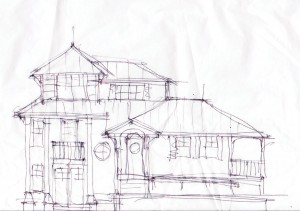
This sketch by Rich Bandera depicts the street side of the home as it uses the roof forms to scale down the structure. “It helps to integrate better into the landscaping of the site—sort of a Japanese garden structure attempt,” Bandera says. “It’s a complex design.” Photo by Bethany Turner
“There are a lot of constraints that developed the design. There’s a flood zone restriction that occurs. The lowest level is built to the standards of that,” Rich notes. “You come into gradual elevation changes as you move through the house. When you come in off of East Bay Street, you’re coming into the living level which is really about four feet above the sidewalk elevation. But you really don’t feel it as you come up.”
On the back side, the Coastal Area Management Act (CAMA) delineates a section on the waterfront in which the Marchettis could not build. “It’s kind of an arc that comes off of a point along the bulkhead, and it’s arcing at about 30 feet along that line, so the deck is very close to that point. The screened porch portion is another point, and the covered deck off the kitchen is another point. You’re not really seeing that, but those are the constraints that shaped the design,” Rich assures.

The screened porch off the main living area offers a view off the Atlantic Ocean, Cape Fear River, and Intracoastal Waterway as they collide in front of Southport. Photo by Bethany Turner
Frank adds the original design of the house called for the back bedrooms to have a straight wall facing the river. “But Rich had to design the sides to be on an angle so we would stay out of the buffer zone,” he continues. “It ended up being great because we got better views, but with the straight walls we were over about two square feet. So Rich angled in one side to compensate and then the other to make it aesthetically right; he did it very artistically.”
Rich explains how working with Frank and Nancy’s program shaped the design, as well. “You’re trying to fit all the pieces and take advantage of the view, but there’s another one of the things they didn’t have with the old house. The tabby wall was all cleaned up from where it had been overgrown,” Rich says of the handiwork Frank put in on the wall. “They wanted a private kind of garden off of the tabby wall to have another outdoor space. That adds a different kind of character to it.”
The oyster-infused sea wall is now capped off with slim stones Frank added in order to save it from further erosion. “The old house was very close to the tabby wall, and it had all kinds of growth on it, and you really couldn’t see it. We wanted to have a space that you could actually see the sea wall and appreciate it,” Frank shares.
The courtyard created by Rich’s home design offers a cool, lower level refuge. “The plan, because of it, shifts. You have this back half that comes out about 15 feet off that wall, and the front half shifts forward so it creates a nice outdoor space,” Rich explains.
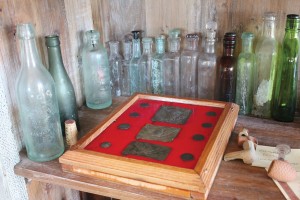
Frank Marchetti finds hundreds of historical treasures along the Southport waterfront. Photo by Bethany Turner
Inside, all of the staircases are consolidated within a small section of the home, with only a few steps in each place to save the split-level design and the Marchettis’ backs in the future. “The half levels help with making it more compact, but it’s condensed so much, you’re able to shift these areas without taking up floor space. So that gives you the ability to have a reasonably sized guest suite and master. The core staircase evolved out of that split-level approach.”
Frank admits when he first glanced at the plans, he couldn’t figure out the staircase situation. “As a matter of fact, the framer for the house said, ‘I’m not quite sure how this is going to work,'” he adds. “But Rich had it right to the T. It all fit in perfectly, also taking into consideration head height. It’s amazing what he can do; Rich sees things that the rest of us mere mortals can’t see.”
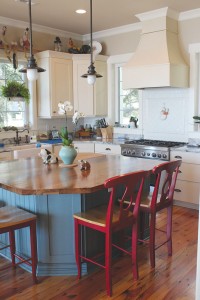
The kitchen remains coastal with its light, airy feel, while accents such as subway tiles, a farmhouse sink, and red bar chairs offer country-chic style. Photo by Bethany Turner
Another remarkable aspect of the home is the fact that Rich and the Marchettis didn’t just give lip service to the CAMA requirements—they went above and beyond.
“There’s real intent and thought into how the stormwater would actually drain and be dissipated before it got back into the river,” Rich explains. “All of the storm leaders come down the side of the house and exit under the crawl space into a big French drain. All those leaders go to the furthest point away from the river and all of that stuff dissipates and infiltrates before going back to the water.”
From the water, the butter yellow home seems larger and more modern than its neighbors in the town. Three stories on the tall half of the house offer three different views of the river, from within the lower natural vegetation to a bird’s eye sight. Yet a lot of the beauty in Rich’s work is his ability to match the scale of the neighborhood as well as keep in mind each home’s relationship to the spaces in its surroundings.
“Within the historical area on the original lots, the original house was built to the setback line,” Rich begins. “But we wanted to give a more historical presence to the street side. The zoning code allows for balconies to project into the setback, and because we had this elevation change, we were able to encroach the balcony into the setback and create that traditional porch structure [on the front of the house]. Really the house is not oriented toward the street like a lot of historical houses. It’s more to the waterside. But it blends in with the large live oak tree [on the right of the site]. The idea was like a Japanese house with hip roofs that sit into the trees. With Frank and Nancy’s idea of creating that courtyard by the tabby wall, it put the taller mass of the house back so it’s not right on top of the street. It’s a little more subtle; the scale of it is a lot more reduced than on the water side. I think it blends in really well.”
The interior design, however, was more up to the homeowners than the governmental restrictions. A guest suite with a private bathroom, walk-in closet and living room has its own access to the outdoor deck. The dining room is the only room in the house that has windows with a grid. It mimics the dining room from the old house, which itself was a home feature in the July 1994 edition of Southern Living. “I wanted to go back and recapture this corner of the old house and the panes that were here because I loved it so much,” Frank shares.
Many of the wooden pieces in the home offer their own mini-history lesson. “All the floors throughout came from a 120-year-old cotton factory in western North Carolina. The guy we bought them from in Wilmington, Chris Metz of Old Growth Riverwood, he also built our dining room table. The wood came from the planks of St. Andrews Church, now Brooklyn Arts Center. These were 150-year-old planks that he made the table and chairs out of. He made the top of the kitchen island out of riverwood harvested from the Cape Fear River.”
Likewise, the builder, George Crane of Crane Building Company, gave the Marchettis a portion of wood that is special in Southport. “George built The Frying Pan restaurant. That was his first commercial and this was his first residential home in Southport,” Frank starts. “So if you notice the beams that are up in the restaurant, our mantle is one of the beams that was leftover.”
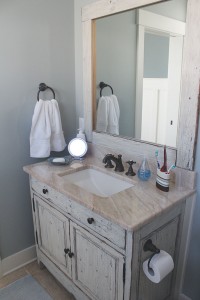 Even the front door, in varying shades of distressed brown and an antique doorknob, has a bit of historical whimsy. “The front door is from the late 1800s. I’d actually bought it to use for a headboard,” Frank says. “When the house burnt down, I decided we were going to use it for the front door. I had it at my workshop and I started to strip it down. Nancy came over to visit one day, and she said, ‘Stop! Don’t do anything more, I want it just like that.’ So that’s where it stopped.”
Even the front door, in varying shades of distressed brown and an antique doorknob, has a bit of historical whimsy. “The front door is from the late 1800s. I’d actually bought it to use for a headboard,” Frank says. “When the house burnt down, I decided we were going to use it for the front door. I had it at my workshop and I started to strip it down. Nancy came over to visit one day, and she said, ‘Stop! Don’t do anything more, I want it just like that.’ So that’s where it stopped.”
The interior decor is reminiscent of Frank and Nancy’s love for farm life and Southport together. Local art appears in a neat hodge podge with rich dark reds and greens, and lots of rustic appeal.
“We both grew up on farms, so we wanted a seaside country aspect. We didn’t want to go overboard on the sea stuff; it’s not your typical little beach cottage. So we tried to maintain a little bit of that but wanted to maintain the country aspect with the farmer sink, the subway tiles and other details,” Frank describes. “I remodel homes now. One thing we had never done before, which was a recommendation by George Crane’s wife, Sara, was to paint the ceiling the same color as the walls, which I had never done. It turned out nice. Nancy picked out all of the fans, and just about all of them have the wood, but it looks a little bit like wood from a ship. I’m retired Navy, too, so we try to put a little bit of that in the home.”
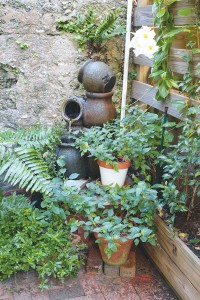
Through Rich Bandera’s design, the Marchettis made great use of their courtyard space, which showcases the old Southport tabby sea wall that dates back to the colonial era. Photo by Bethany Turner
While Frank swears he wasn’t a history buff before moving to Southport, his treasures tell a different story. He takes full advantage of their location on the waterfront, catching about 60 flounder per year off their dock and enjoying the avian wildlife that perches nearby. Almost every day, Frank walks the waterfront at low tide, and he uncovers priceless prizes in the sand or floating in the water. Throughout the house he has collections of glass inkwells, old bullets and buttons, pipes and glasses, old money, along with belt buckles from the Revolutionary War, the War of 1812, and the Civil War. He’s even found a Civil War bayonette, a “Christmas Coke”—a glass Coca-Cola bottle dated Dec. 25, 1923 from Elizabeth City, NC, and a Thanksgiving Coke dated 1917.
Frank shows off his bounty with wide, excited eyes—the same enthusiasm he exhibits when speaking of the unique details Rich designed into his home. The passionate man seems content with his life by the sea, enhanced by the hands of a most talented architect.






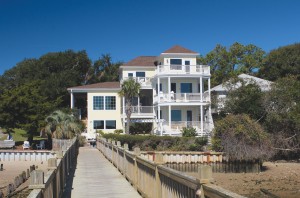

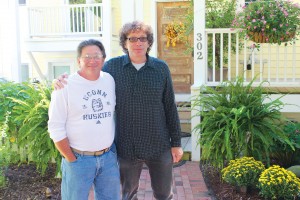
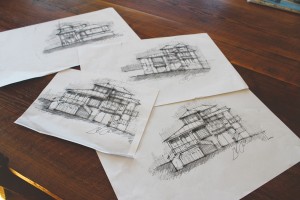

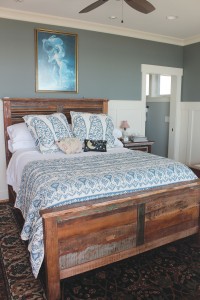





Leave a Reply